Climate Change in Project Management
VerifiedAdded on 2022/11/13
|14
|3709
|105
AI Summary
This paper discusses the impact of climate change on project management in West Africa, with a focus on agriculture and water resources. It covers risks, vulnerabilities, and tools for analysis and adaptation.
Contribute Materials
Your contribution can guide someone’s learning journey. Share your
documents today.
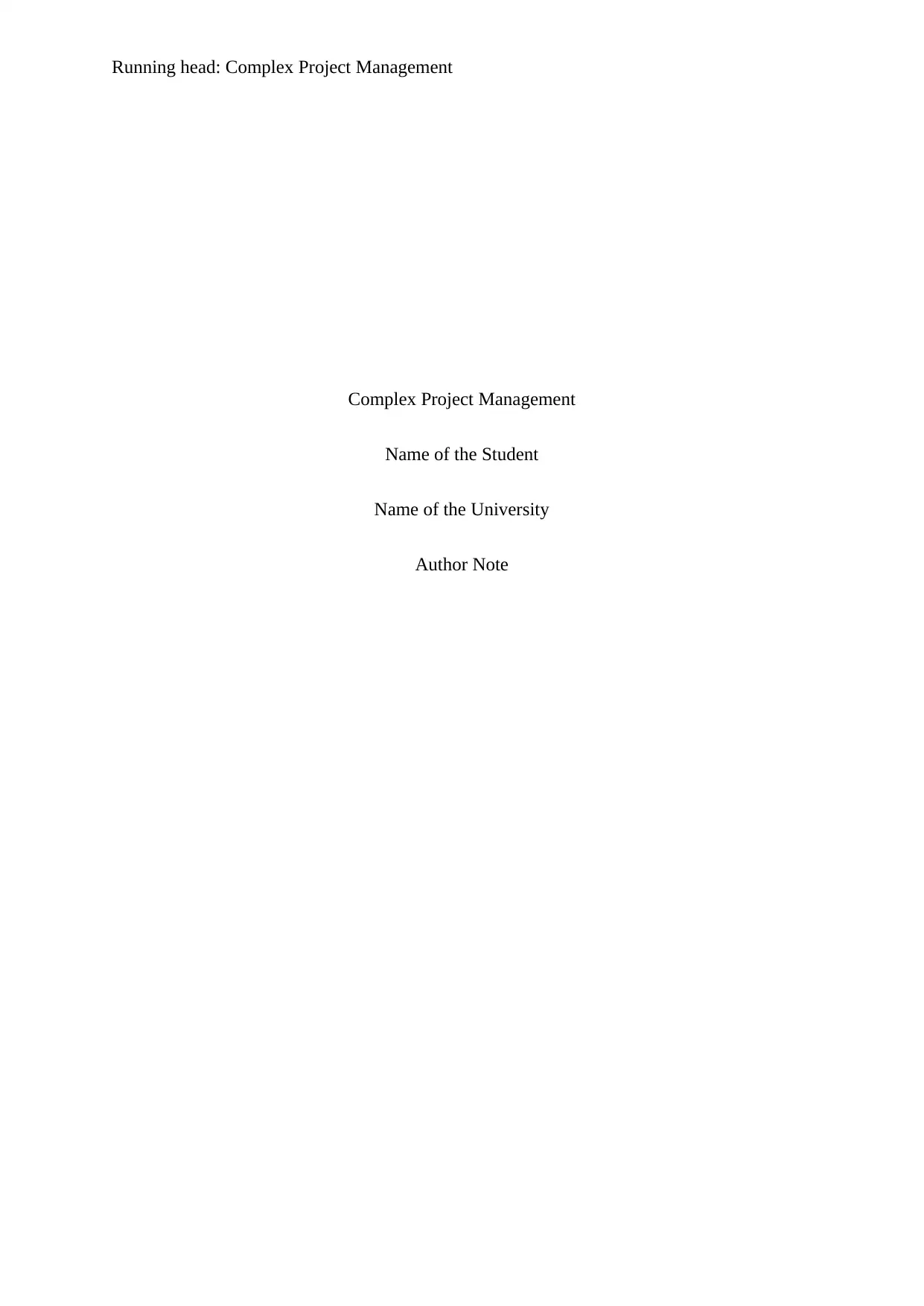
Running head: Complex Project Management
Complex Project Management
Name of the Student
Name of the University
Author Note
Complex Project Management
Name of the Student
Name of the University
Author Note
Secure Best Marks with AI Grader
Need help grading? Try our AI Grader for instant feedback on your assignments.
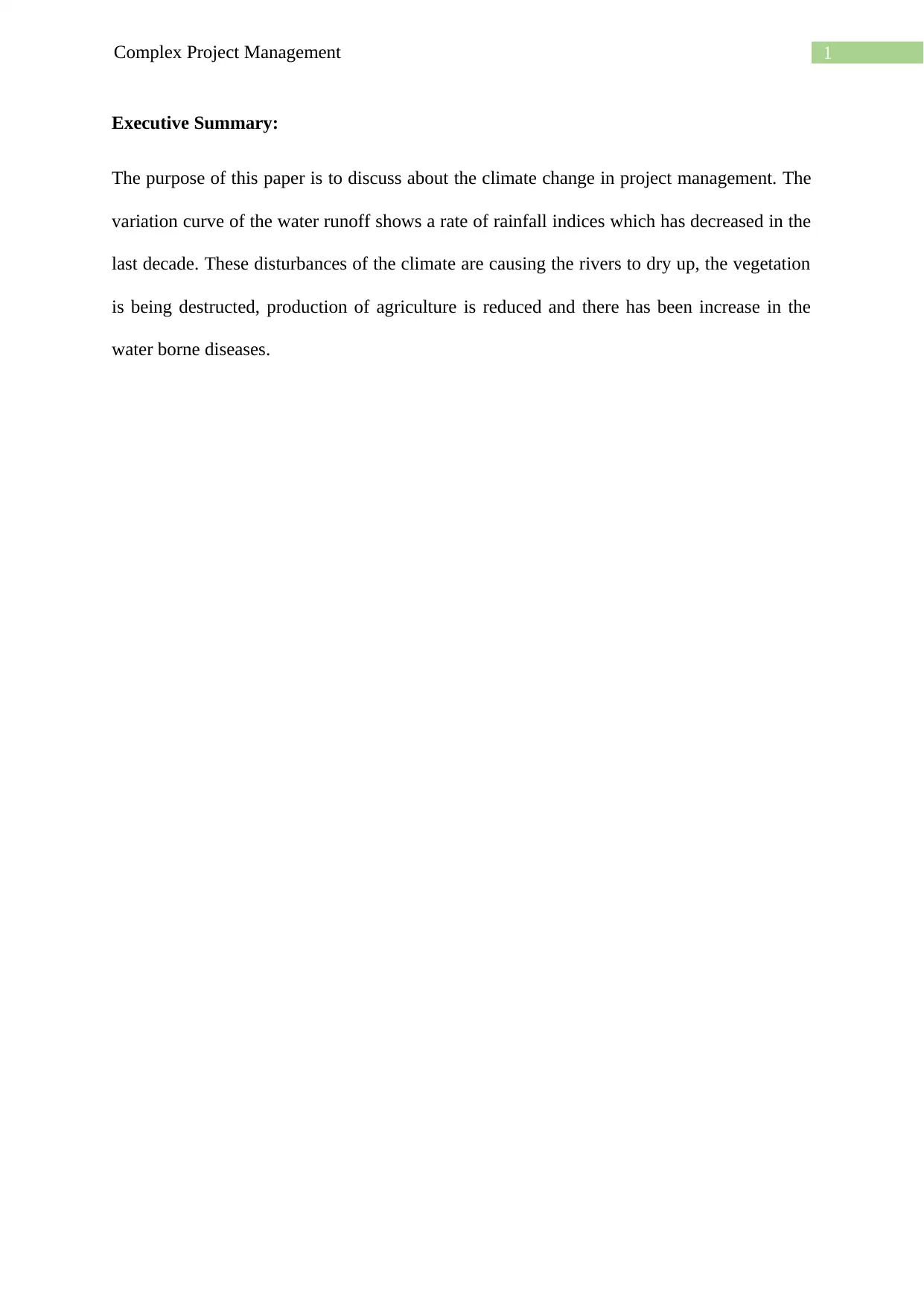
Complex Project Management 1
Executive Summary:
The purpose of this paper is to discuss about the climate change in project management. The
variation curve of the water runoff shows a rate of rainfall indices which has decreased in the
last decade. These disturbances of the climate are causing the rivers to dry up, the vegetation
is being destructed, production of agriculture is reduced and there has been increase in the
water borne diseases.
Executive Summary:
The purpose of this paper is to discuss about the climate change in project management. The
variation curve of the water runoff shows a rate of rainfall indices which has decreased in the
last decade. These disturbances of the climate are causing the rivers to dry up, the vegetation
is being destructed, production of agriculture is reduced and there has been increase in the
water borne diseases.
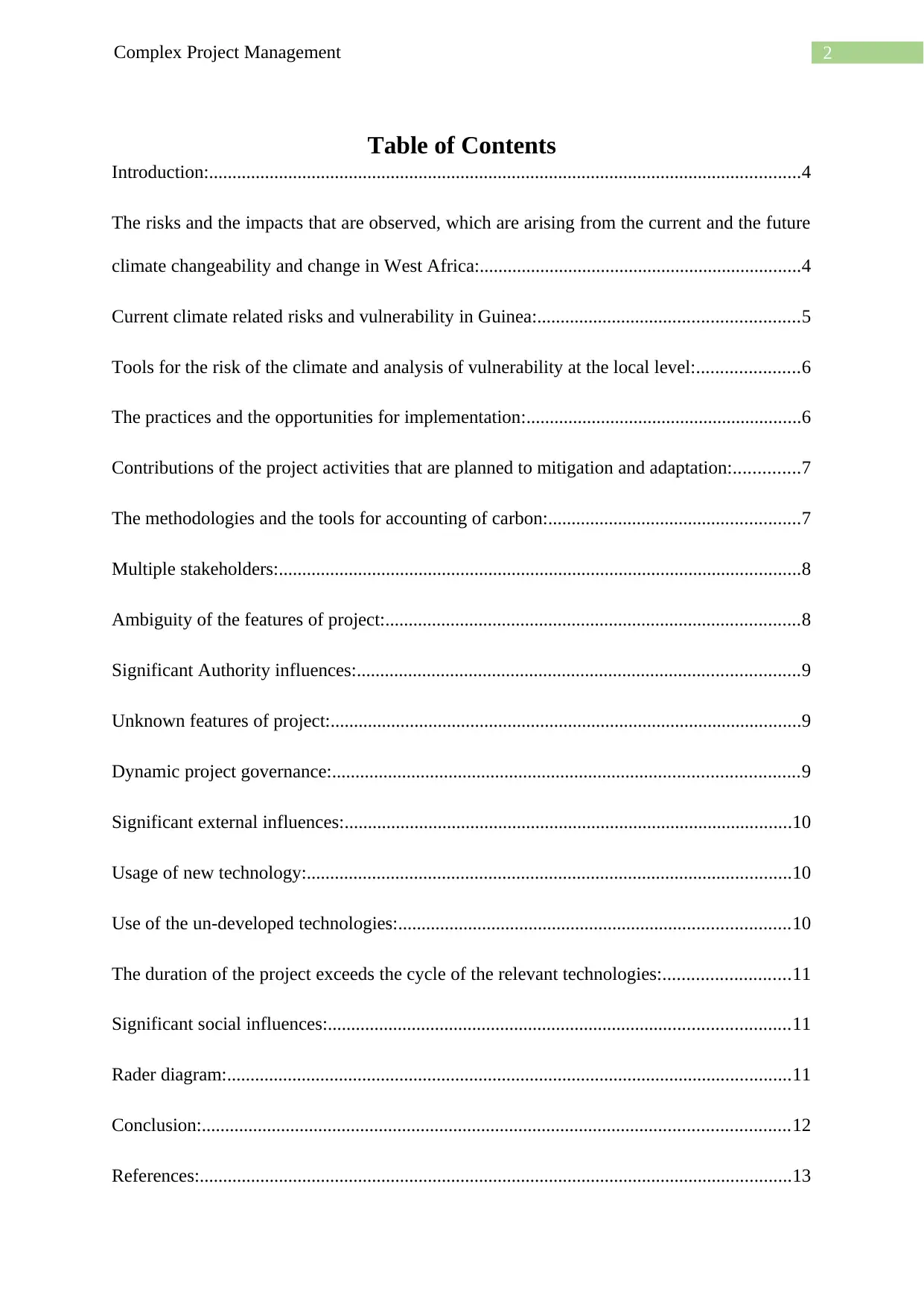
2Complex Project Management
Table of Contents
Introduction:...............................................................................................................................4
The risks and the impacts that are observed, which are arising from the current and the future
climate changeability and change in West Africa:.....................................................................4
Current climate related risks and vulnerability in Guinea:........................................................5
Tools for the risk of the climate and analysis of vulnerability at the local level:......................6
The practices and the opportunities for implementation:...........................................................6
Contributions of the project activities that are planned to mitigation and adaptation:..............7
The methodologies and the tools for accounting of carbon:......................................................7
Multiple stakeholders:................................................................................................................8
Ambiguity of the features of project:.........................................................................................8
Significant Authority influences:...............................................................................................9
Unknown features of project:.....................................................................................................9
Dynamic project governance:....................................................................................................9
Significant external influences:................................................................................................10
Usage of new technology:........................................................................................................10
Use of the un-developed technologies:....................................................................................10
The duration of the project exceeds the cycle of the relevant technologies:...........................11
Significant social influences:...................................................................................................11
Rader diagram:.........................................................................................................................11
Conclusion:..............................................................................................................................12
References:...............................................................................................................................13
Table of Contents
Introduction:...............................................................................................................................4
The risks and the impacts that are observed, which are arising from the current and the future
climate changeability and change in West Africa:.....................................................................4
Current climate related risks and vulnerability in Guinea:........................................................5
Tools for the risk of the climate and analysis of vulnerability at the local level:......................6
The practices and the opportunities for implementation:...........................................................6
Contributions of the project activities that are planned to mitigation and adaptation:..............7
The methodologies and the tools for accounting of carbon:......................................................7
Multiple stakeholders:................................................................................................................8
Ambiguity of the features of project:.........................................................................................8
Significant Authority influences:...............................................................................................9
Unknown features of project:.....................................................................................................9
Dynamic project governance:....................................................................................................9
Significant external influences:................................................................................................10
Usage of new technology:........................................................................................................10
Use of the un-developed technologies:....................................................................................10
The duration of the project exceeds the cycle of the relevant technologies:...........................11
Significant social influences:...................................................................................................11
Rader diagram:.........................................................................................................................11
Conclusion:..............................................................................................................................12
References:...............................................................................................................................13
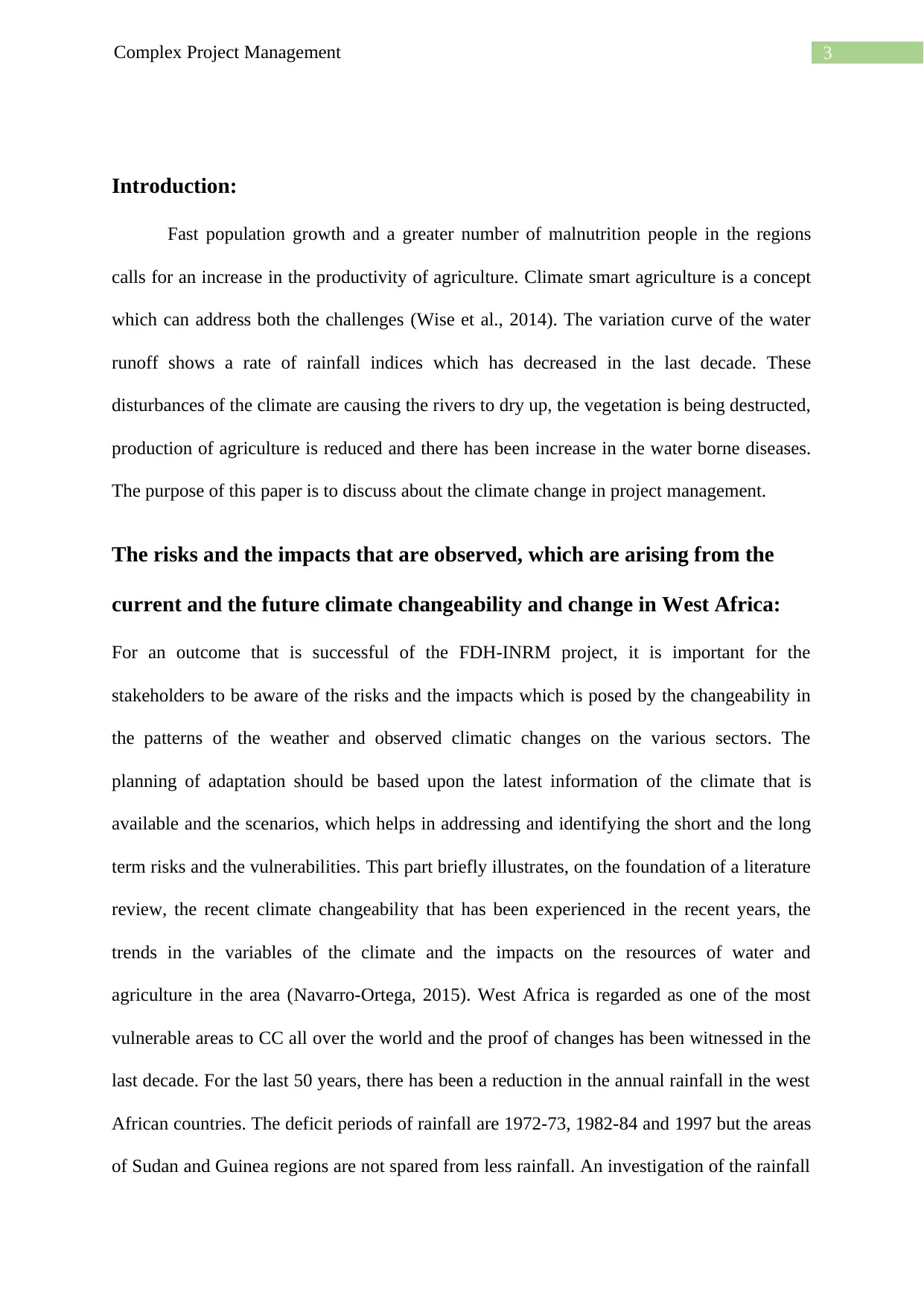
3Complex Project Management
Introduction:
Fast population growth and a greater number of malnutrition people in the regions
calls for an increase in the productivity of agriculture. Climate smart agriculture is a concept
which can address both the challenges (Wise et al., 2014). The variation curve of the water
runoff shows a rate of rainfall indices which has decreased in the last decade. These
disturbances of the climate are causing the rivers to dry up, the vegetation is being destructed,
production of agriculture is reduced and there has been increase in the water borne diseases.
The purpose of this paper is to discuss about the climate change in project management.
The risks and the impacts that are observed, which are arising from the
current and the future climate changeability and change in West Africa:
For an outcome that is successful of the FDH-INRM project, it is important for the
stakeholders to be aware of the risks and the impacts which is posed by the changeability in
the patterns of the weather and observed climatic changes on the various sectors. The
planning of adaptation should be based upon the latest information of the climate that is
available and the scenarios, which helps in addressing and identifying the short and the long
term risks and the vulnerabilities. This part briefly illustrates, on the foundation of a literature
review, the recent climate changeability that has been experienced in the recent years, the
trends in the variables of the climate and the impacts on the resources of water and
agriculture in the area (Navarro-Ortega, 2015). West Africa is regarded as one of the most
vulnerable areas to CC all over the world and the proof of changes has been witnessed in the
last decade. For the last 50 years, there has been a reduction in the annual rainfall in the west
African countries. The deficit periods of rainfall are 1972-73, 1982-84 and 1997 but the areas
of Sudan and Guinea regions are not spared from less rainfall. An investigation of the rainfall
Introduction:
Fast population growth and a greater number of malnutrition people in the regions
calls for an increase in the productivity of agriculture. Climate smart agriculture is a concept
which can address both the challenges (Wise et al., 2014). The variation curve of the water
runoff shows a rate of rainfall indices which has decreased in the last decade. These
disturbances of the climate are causing the rivers to dry up, the vegetation is being destructed,
production of agriculture is reduced and there has been increase in the water borne diseases.
The purpose of this paper is to discuss about the climate change in project management.
The risks and the impacts that are observed, which are arising from the
current and the future climate changeability and change in West Africa:
For an outcome that is successful of the FDH-INRM project, it is important for the
stakeholders to be aware of the risks and the impacts which is posed by the changeability in
the patterns of the weather and observed climatic changes on the various sectors. The
planning of adaptation should be based upon the latest information of the climate that is
available and the scenarios, which helps in addressing and identifying the short and the long
term risks and the vulnerabilities. This part briefly illustrates, on the foundation of a literature
review, the recent climate changeability that has been experienced in the recent years, the
trends in the variables of the climate and the impacts on the resources of water and
agriculture in the area (Navarro-Ortega, 2015). West Africa is regarded as one of the most
vulnerable areas to CC all over the world and the proof of changes has been witnessed in the
last decade. For the last 50 years, there has been a reduction in the annual rainfall in the west
African countries. The deficit periods of rainfall are 1972-73, 1982-84 and 1997 but the areas
of Sudan and Guinea regions are not spared from less rainfall. An investigation of the rainfall
Secure Best Marks with AI Grader
Need help grading? Try our AI Grader for instant feedback on your assignments.
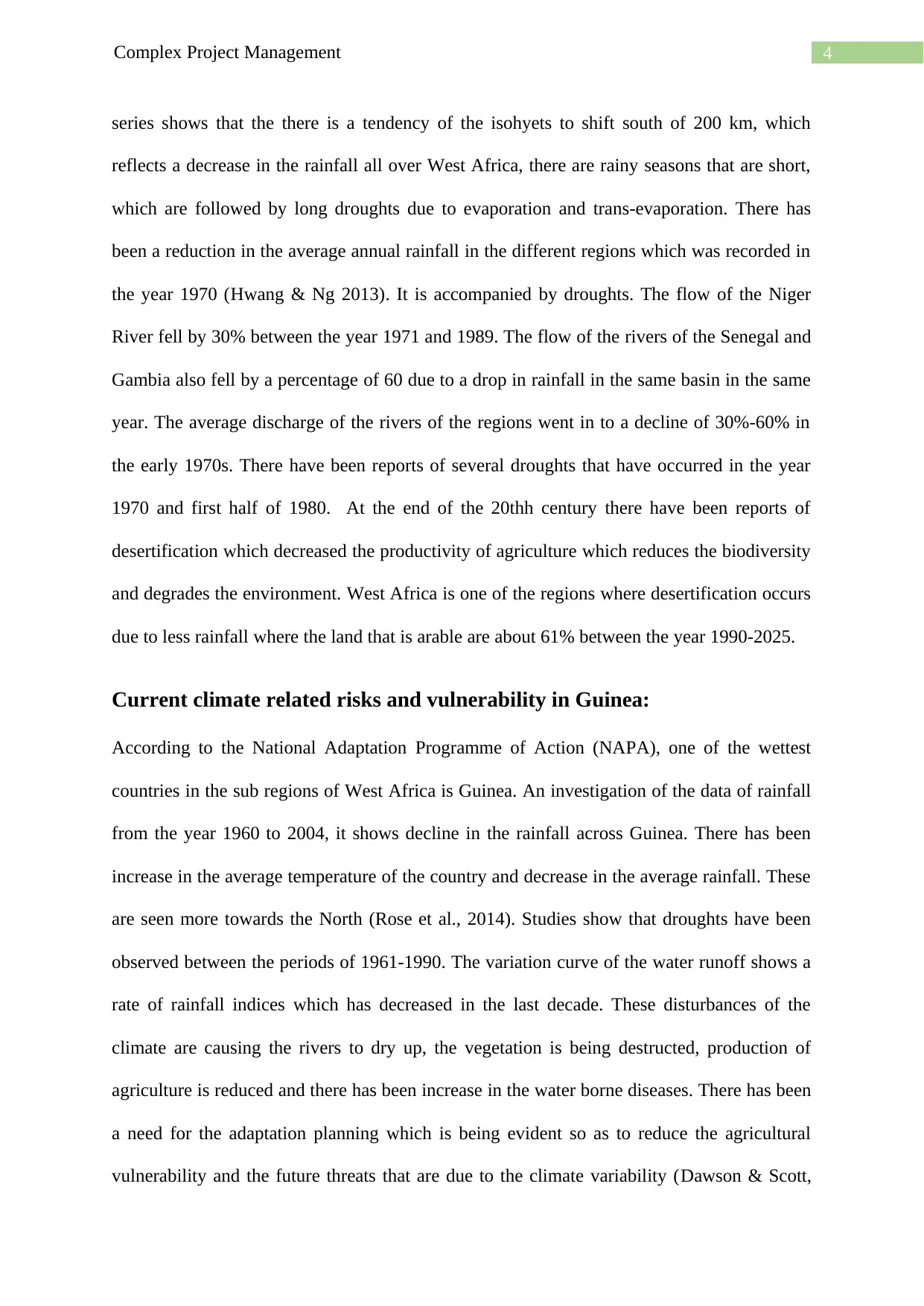
4Complex Project Management
series shows that the there is a tendency of the isohyets to shift south of 200 km, which
reflects a decrease in the rainfall all over West Africa, there are rainy seasons that are short,
which are followed by long droughts due to evaporation and trans-evaporation. There has
been a reduction in the average annual rainfall in the different regions which was recorded in
the year 1970 (Hwang & Ng 2013). It is accompanied by droughts. The flow of the Niger
River fell by 30% between the year 1971 and 1989. The flow of the rivers of the Senegal and
Gambia also fell by a percentage of 60 due to a drop in rainfall in the same basin in the same
year. The average discharge of the rivers of the regions went in to a decline of 30%-60% in
the early 1970s. There have been reports of several droughts that have occurred in the year
1970 and first half of 1980. At the end of the 20thh century there have been reports of
desertification which decreased the productivity of agriculture which reduces the biodiversity
and degrades the environment. West Africa is one of the regions where desertification occurs
due to less rainfall where the land that is arable are about 61% between the year 1990-2025.
Current climate related risks and vulnerability in Guinea:
According to the National Adaptation Programme of Action (NAPA), one of the wettest
countries in the sub regions of West Africa is Guinea. An investigation of the data of rainfall
from the year 1960 to 2004, it shows decline in the rainfall across Guinea. There has been
increase in the average temperature of the country and decrease in the average rainfall. These
are seen more towards the North (Rose et al., 2014). Studies show that droughts have been
observed between the periods of 1961-1990. The variation curve of the water runoff shows a
rate of rainfall indices which has decreased in the last decade. These disturbances of the
climate are causing the rivers to dry up, the vegetation is being destructed, production of
agriculture is reduced and there has been increase in the water borne diseases. There has been
a need for the adaptation planning which is being evident so as to reduce the agricultural
vulnerability and the future threats that are due to the climate variability (Dawson & Scott,
series shows that the there is a tendency of the isohyets to shift south of 200 km, which
reflects a decrease in the rainfall all over West Africa, there are rainy seasons that are short,
which are followed by long droughts due to evaporation and trans-evaporation. There has
been a reduction in the average annual rainfall in the different regions which was recorded in
the year 1970 (Hwang & Ng 2013). It is accompanied by droughts. The flow of the Niger
River fell by 30% between the year 1971 and 1989. The flow of the rivers of the Senegal and
Gambia also fell by a percentage of 60 due to a drop in rainfall in the same basin in the same
year. The average discharge of the rivers of the regions went in to a decline of 30%-60% in
the early 1970s. There have been reports of several droughts that have occurred in the year
1970 and first half of 1980. At the end of the 20thh century there have been reports of
desertification which decreased the productivity of agriculture which reduces the biodiversity
and degrades the environment. West Africa is one of the regions where desertification occurs
due to less rainfall where the land that is arable are about 61% between the year 1990-2025.
Current climate related risks and vulnerability in Guinea:
According to the National Adaptation Programme of Action (NAPA), one of the wettest
countries in the sub regions of West Africa is Guinea. An investigation of the data of rainfall
from the year 1960 to 2004, it shows decline in the rainfall across Guinea. There has been
increase in the average temperature of the country and decrease in the average rainfall. These
are seen more towards the North (Rose et al., 2014). Studies show that droughts have been
observed between the periods of 1961-1990. The variation curve of the water runoff shows a
rate of rainfall indices which has decreased in the last decade. These disturbances of the
climate are causing the rivers to dry up, the vegetation is being destructed, production of
agriculture is reduced and there has been increase in the water borne diseases. There has been
a need for the adaptation planning which is being evident so as to reduce the agricultural
vulnerability and the future threats that are due to the climate variability (Dawson & Scott,
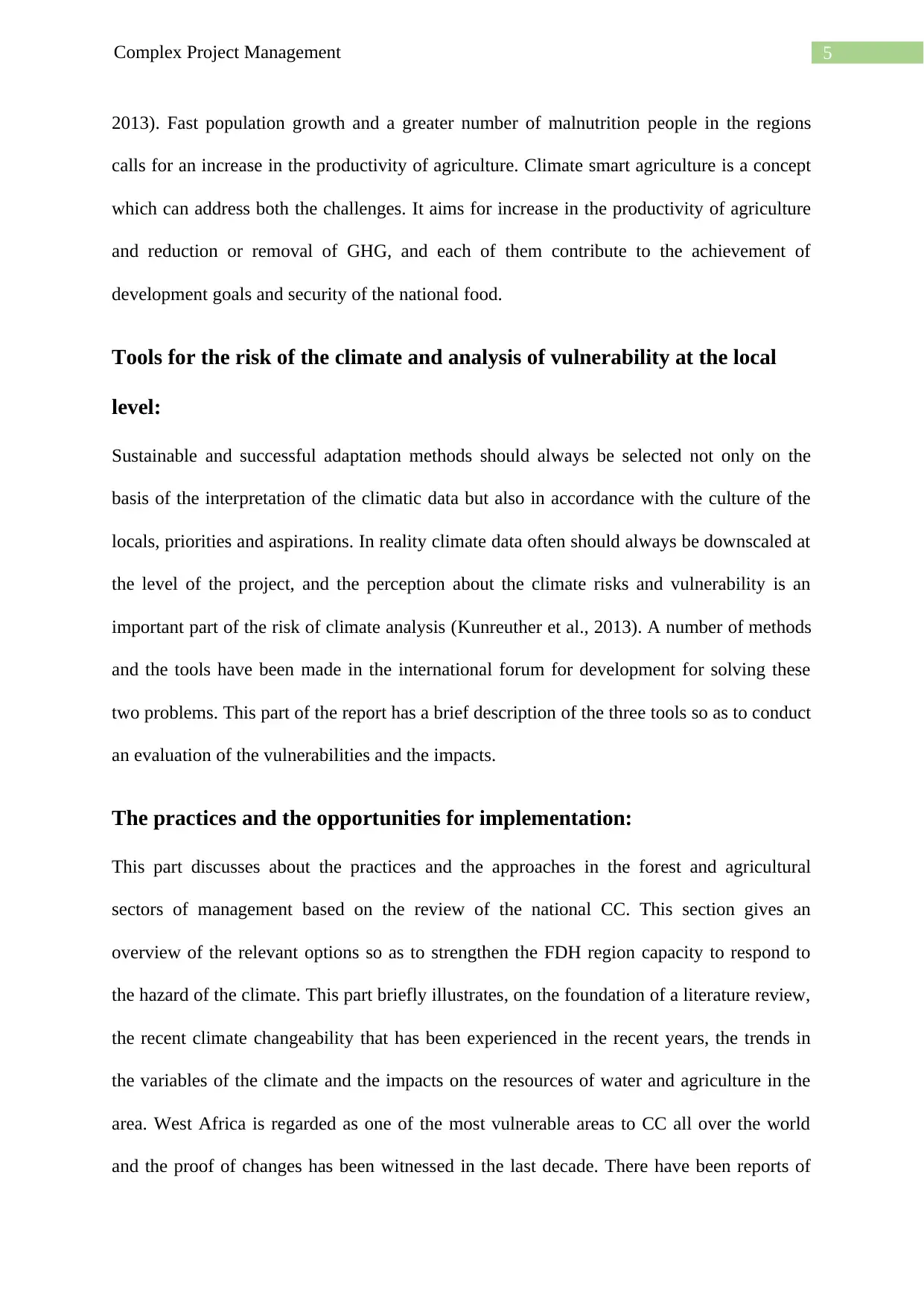
5Complex Project Management
2013). Fast population growth and a greater number of malnutrition people in the regions
calls for an increase in the productivity of agriculture. Climate smart agriculture is a concept
which can address both the challenges. It aims for increase in the productivity of agriculture
and reduction or removal of GHG, and each of them contribute to the achievement of
development goals and security of the national food.
Tools for the risk of the climate and analysis of vulnerability at the local
level:
Sustainable and successful adaptation methods should always be selected not only on the
basis of the interpretation of the climatic data but also in accordance with the culture of the
locals, priorities and aspirations. In reality climate data often should always be downscaled at
the level of the project, and the perception about the climate risks and vulnerability is an
important part of the risk of climate analysis (Kunreuther et al., 2013). A number of methods
and the tools have been made in the international forum for development for solving these
two problems. This part of the report has a brief description of the three tools so as to conduct
an evaluation of the vulnerabilities and the impacts.
The practices and the opportunities for implementation:
This part discusses about the practices and the approaches in the forest and agricultural
sectors of management based on the review of the national CC. This section gives an
overview of the relevant options so as to strengthen the FDH region capacity to respond to
the hazard of the climate. This part briefly illustrates, on the foundation of a literature review,
the recent climate changeability that has been experienced in the recent years, the trends in
the variables of the climate and the impacts on the resources of water and agriculture in the
area. West Africa is regarded as one of the most vulnerable areas to CC all over the world
and the proof of changes has been witnessed in the last decade. There have been reports of
2013). Fast population growth and a greater number of malnutrition people in the regions
calls for an increase in the productivity of agriculture. Climate smart agriculture is a concept
which can address both the challenges. It aims for increase in the productivity of agriculture
and reduction or removal of GHG, and each of them contribute to the achievement of
development goals and security of the national food.
Tools for the risk of the climate and analysis of vulnerability at the local
level:
Sustainable and successful adaptation methods should always be selected not only on the
basis of the interpretation of the climatic data but also in accordance with the culture of the
locals, priorities and aspirations. In reality climate data often should always be downscaled at
the level of the project, and the perception about the climate risks and vulnerability is an
important part of the risk of climate analysis (Kunreuther et al., 2013). A number of methods
and the tools have been made in the international forum for development for solving these
two problems. This part of the report has a brief description of the three tools so as to conduct
an evaluation of the vulnerabilities and the impacts.
The practices and the opportunities for implementation:
This part discusses about the practices and the approaches in the forest and agricultural
sectors of management based on the review of the national CC. This section gives an
overview of the relevant options so as to strengthen the FDH region capacity to respond to
the hazard of the climate. This part briefly illustrates, on the foundation of a literature review,
the recent climate changeability that has been experienced in the recent years, the trends in
the variables of the climate and the impacts on the resources of water and agriculture in the
area. West Africa is regarded as one of the most vulnerable areas to CC all over the world
and the proof of changes has been witnessed in the last decade. There have been reports of
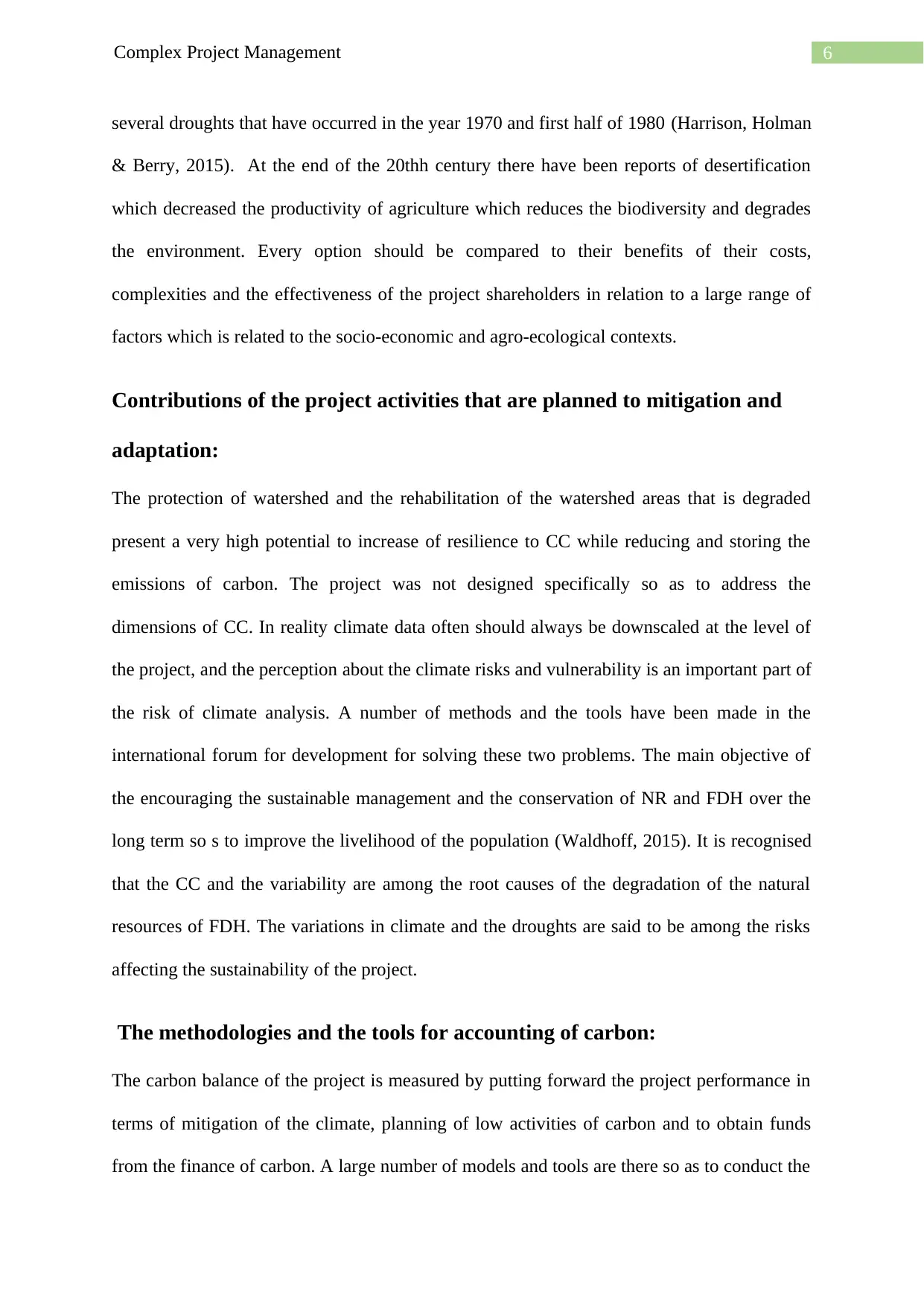
6Complex Project Management
several droughts that have occurred in the year 1970 and first half of 1980 (Harrison, Holman
& Berry, 2015). At the end of the 20thh century there have been reports of desertification
which decreased the productivity of agriculture which reduces the biodiversity and degrades
the environment. Every option should be compared to their benefits of their costs,
complexities and the effectiveness of the project shareholders in relation to a large range of
factors which is related to the socio-economic and agro-ecological contexts.
Contributions of the project activities that are planned to mitigation and
adaptation:
The protection of watershed and the rehabilitation of the watershed areas that is degraded
present a very high potential to increase of resilience to CC while reducing and storing the
emissions of carbon. The project was not designed specifically so as to address the
dimensions of CC. In reality climate data often should always be downscaled at the level of
the project, and the perception about the climate risks and vulnerability is an important part of
the risk of climate analysis. A number of methods and the tools have been made in the
international forum for development for solving these two problems. The main objective of
the encouraging the sustainable management and the conservation of NR and FDH over the
long term so s to improve the livelihood of the population (Waldhoff, 2015). It is recognised
that the CC and the variability are among the root causes of the degradation of the natural
resources of FDH. The variations in climate and the droughts are said to be among the risks
affecting the sustainability of the project.
The methodologies and the tools for accounting of carbon:
The carbon balance of the project is measured by putting forward the project performance in
terms of mitigation of the climate, planning of low activities of carbon and to obtain funds
from the finance of carbon. A large number of models and tools are there so as to conduct the
several droughts that have occurred in the year 1970 and first half of 1980 (Harrison, Holman
& Berry, 2015). At the end of the 20thh century there have been reports of desertification
which decreased the productivity of agriculture which reduces the biodiversity and degrades
the environment. Every option should be compared to their benefits of their costs,
complexities and the effectiveness of the project shareholders in relation to a large range of
factors which is related to the socio-economic and agro-ecological contexts.
Contributions of the project activities that are planned to mitigation and
adaptation:
The protection of watershed and the rehabilitation of the watershed areas that is degraded
present a very high potential to increase of resilience to CC while reducing and storing the
emissions of carbon. The project was not designed specifically so as to address the
dimensions of CC. In reality climate data often should always be downscaled at the level of
the project, and the perception about the climate risks and vulnerability is an important part of
the risk of climate analysis. A number of methods and the tools have been made in the
international forum for development for solving these two problems. The main objective of
the encouraging the sustainable management and the conservation of NR and FDH over the
long term so s to improve the livelihood of the population (Waldhoff, 2015). It is recognised
that the CC and the variability are among the root causes of the degradation of the natural
resources of FDH. The variations in climate and the droughts are said to be among the risks
affecting the sustainability of the project.
The methodologies and the tools for accounting of carbon:
The carbon balance of the project is measured by putting forward the project performance in
terms of mitigation of the climate, planning of low activities of carbon and to obtain funds
from the finance of carbon. A large number of models and tools are there so as to conduct the
Paraphrase This Document
Need a fresh take? Get an instant paraphrase of this document with our AI Paraphraser

7Complex Project Management
accounting of carbon is available. They vary in scale, aim, land use management,
geographical coverage and the pools of carbon. As result they have high variable in number
and the details of the parameters that are given in input and the output accuracy. At present
there are no model which can be considered to be standard.
Multiple stakeholders:
The stakeholders are the individuals or the group of the individuals, who have a
potential impact and interest in an organisation. At the place of applying the attitude for wait
and see, all of the organisations are taking one approach which is proactive at the present
time, because the organisations are paying so much attention to the consequences, risks as
well as the threats for change that is happening in the climate. The complexity factor is
almost fifty-seven percent. The weight is having validity for the change in climate. All of the
organisations are beginning to look down upon what is the importance of the stakeholders
and their engagement as the responses which is so much strategic against the battle that is
against the change that is happening in the climate.
Ambiguity of the features of project:
The states which are developed are also committed to the public based financing
which is having so much importance for the adoption that is in the change that is happening
in the climate change. This is so much delegated through the states that the monitoring as
well as the implementation of the adoption for the international based companies which are
already existed. The complexity factor for the ambiguity of the project features is around
48% as well as the ambiguity is having the validity for the change in the climate (Bulkeley &
Newell, 2015). This is also noted by all of the scholars which the discretion of the states that
are delegated to all of the organisation which are specializes for the performance of tasks on
accounting of carbon is available. They vary in scale, aim, land use management,
geographical coverage and the pools of carbon. As result they have high variable in number
and the details of the parameters that are given in input and the output accuracy. At present
there are no model which can be considered to be standard.
Multiple stakeholders:
The stakeholders are the individuals or the group of the individuals, who have a
potential impact and interest in an organisation. At the place of applying the attitude for wait
and see, all of the organisations are taking one approach which is proactive at the present
time, because the organisations are paying so much attention to the consequences, risks as
well as the threats for change that is happening in the climate. The complexity factor is
almost fifty-seven percent. The weight is having validity for the change in climate. All of the
organisations are beginning to look down upon what is the importance of the stakeholders
and their engagement as the responses which is so much strategic against the battle that is
against the change that is happening in the climate.
Ambiguity of the features of project:
The states which are developed are also committed to the public based financing
which is having so much importance for the adoption that is in the change that is happening
in the climate change. This is so much delegated through the states that the monitoring as
well as the implementation of the adoption for the international based companies which are
already existed. The complexity factor for the ambiguity of the project features is around
48% as well as the ambiguity is having the validity for the change in the climate (Bulkeley &
Newell, 2015). This is also noted by all of the scholars which the discretion of the states that
are delegated to all of the organisation which are specializes for the performance of tasks on
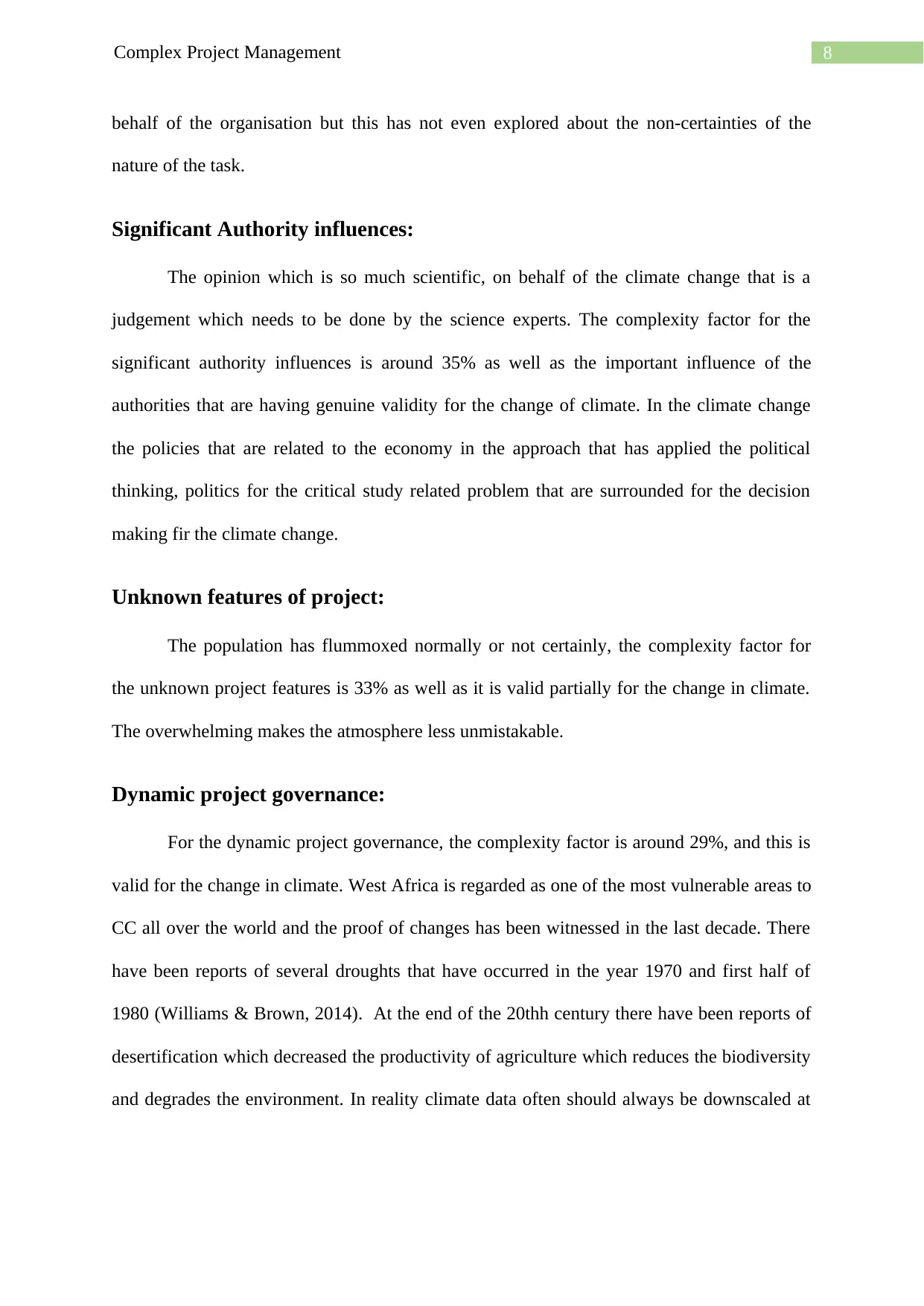
8Complex Project Management
behalf of the organisation but this has not even explored about the non-certainties of the
nature of the task.
Significant Authority influences:
The opinion which is so much scientific, on behalf of the climate change that is a
judgement which needs to be done by the science experts. The complexity factor for the
significant authority influences is around 35% as well as the important influence of the
authorities that are having genuine validity for the change of climate. In the climate change
the policies that are related to the economy in the approach that has applied the political
thinking, politics for the critical study related problem that are surrounded for the decision
making fir the climate change.
Unknown features of project:
The population has flummoxed normally or not certainly, the complexity factor for
the unknown project features is 33% as well as it is valid partially for the change in climate.
The overwhelming makes the atmosphere less unmistakable.
Dynamic project governance:
For the dynamic project governance, the complexity factor is around 29%, and this is
valid for the change in climate. West Africa is regarded as one of the most vulnerable areas to
CC all over the world and the proof of changes has been witnessed in the last decade. There
have been reports of several droughts that have occurred in the year 1970 and first half of
1980 (Williams & Brown, 2014). At the end of the 20thh century there have been reports of
desertification which decreased the productivity of agriculture which reduces the biodiversity
and degrades the environment. In reality climate data often should always be downscaled at
behalf of the organisation but this has not even explored about the non-certainties of the
nature of the task.
Significant Authority influences:
The opinion which is so much scientific, on behalf of the climate change that is a
judgement which needs to be done by the science experts. The complexity factor for the
significant authority influences is around 35% as well as the important influence of the
authorities that are having genuine validity for the change of climate. In the climate change
the policies that are related to the economy in the approach that has applied the political
thinking, politics for the critical study related problem that are surrounded for the decision
making fir the climate change.
Unknown features of project:
The population has flummoxed normally or not certainly, the complexity factor for
the unknown project features is 33% as well as it is valid partially for the change in climate.
The overwhelming makes the atmosphere less unmistakable.
Dynamic project governance:
For the dynamic project governance, the complexity factor is around 29%, and this is
valid for the change in climate. West Africa is regarded as one of the most vulnerable areas to
CC all over the world and the proof of changes has been witnessed in the last decade. There
have been reports of several droughts that have occurred in the year 1970 and first half of
1980 (Williams & Brown, 2014). At the end of the 20thh century there have been reports of
desertification which decreased the productivity of agriculture which reduces the biodiversity
and degrades the environment. In reality climate data often should always be downscaled at
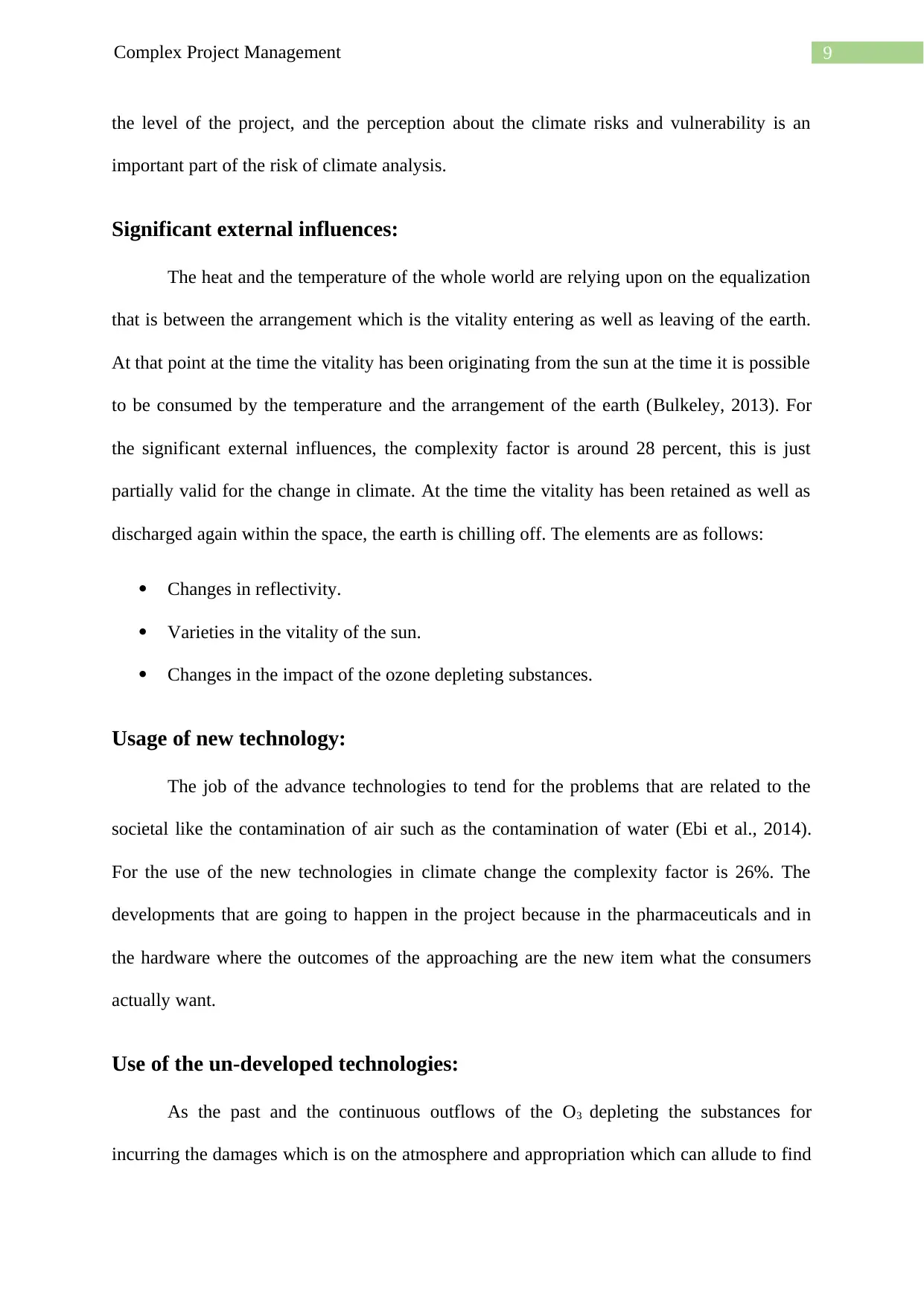
9Complex Project Management
the level of the project, and the perception about the climate risks and vulnerability is an
important part of the risk of climate analysis.
Significant external influences:
The heat and the temperature of the whole world are relying upon on the equalization
that is between the arrangement which is the vitality entering as well as leaving of the earth.
At that point at the time the vitality has been originating from the sun at the time it is possible
to be consumed by the temperature and the arrangement of the earth (Bulkeley, 2013). For
the significant external influences, the complexity factor is around 28 percent, this is just
partially valid for the change in climate. At the time the vitality has been retained as well as
discharged again within the space, the earth is chilling off. The elements are as follows:
Changes in reflectivity.
Varieties in the vitality of the sun.
Changes in the impact of the ozone depleting substances.
Usage of new technology:
The job of the advance technologies to tend for the problems that are related to the
societal like the contamination of air such as the contamination of water (Ebi et al., 2014).
For the use of the new technologies in climate change the complexity factor is 26%. The
developments that are going to happen in the project because in the pharmaceuticals and in
the hardware where the outcomes of the approaching are the new item what the consumers
actually want.
Use of the un-developed technologies:
As the past and the continuous outflows of the O3 depleting the substances for
incurring the damages which is on the atmosphere and appropriation which can allude to find
the level of the project, and the perception about the climate risks and vulnerability is an
important part of the risk of climate analysis.
Significant external influences:
The heat and the temperature of the whole world are relying upon on the equalization
that is between the arrangement which is the vitality entering as well as leaving of the earth.
At that point at the time the vitality has been originating from the sun at the time it is possible
to be consumed by the temperature and the arrangement of the earth (Bulkeley, 2013). For
the significant external influences, the complexity factor is around 28 percent, this is just
partially valid for the change in climate. At the time the vitality has been retained as well as
discharged again within the space, the earth is chilling off. The elements are as follows:
Changes in reflectivity.
Varieties in the vitality of the sun.
Changes in the impact of the ozone depleting substances.
Usage of new technology:
The job of the advance technologies to tend for the problems that are related to the
societal like the contamination of air such as the contamination of water (Ebi et al., 2014).
For the use of the new technologies in climate change the complexity factor is 26%. The
developments that are going to happen in the project because in the pharmaceuticals and in
the hardware where the outcomes of the approaching are the new item what the consumers
actually want.
Use of the un-developed technologies:
As the past and the continuous outflows of the O3 depleting the substances for
incurring the damages which is on the atmosphere and appropriation which can allude to find
Secure Best Marks with AI Grader
Need help grading? Try our AI Grader for instant feedback on your assignments.
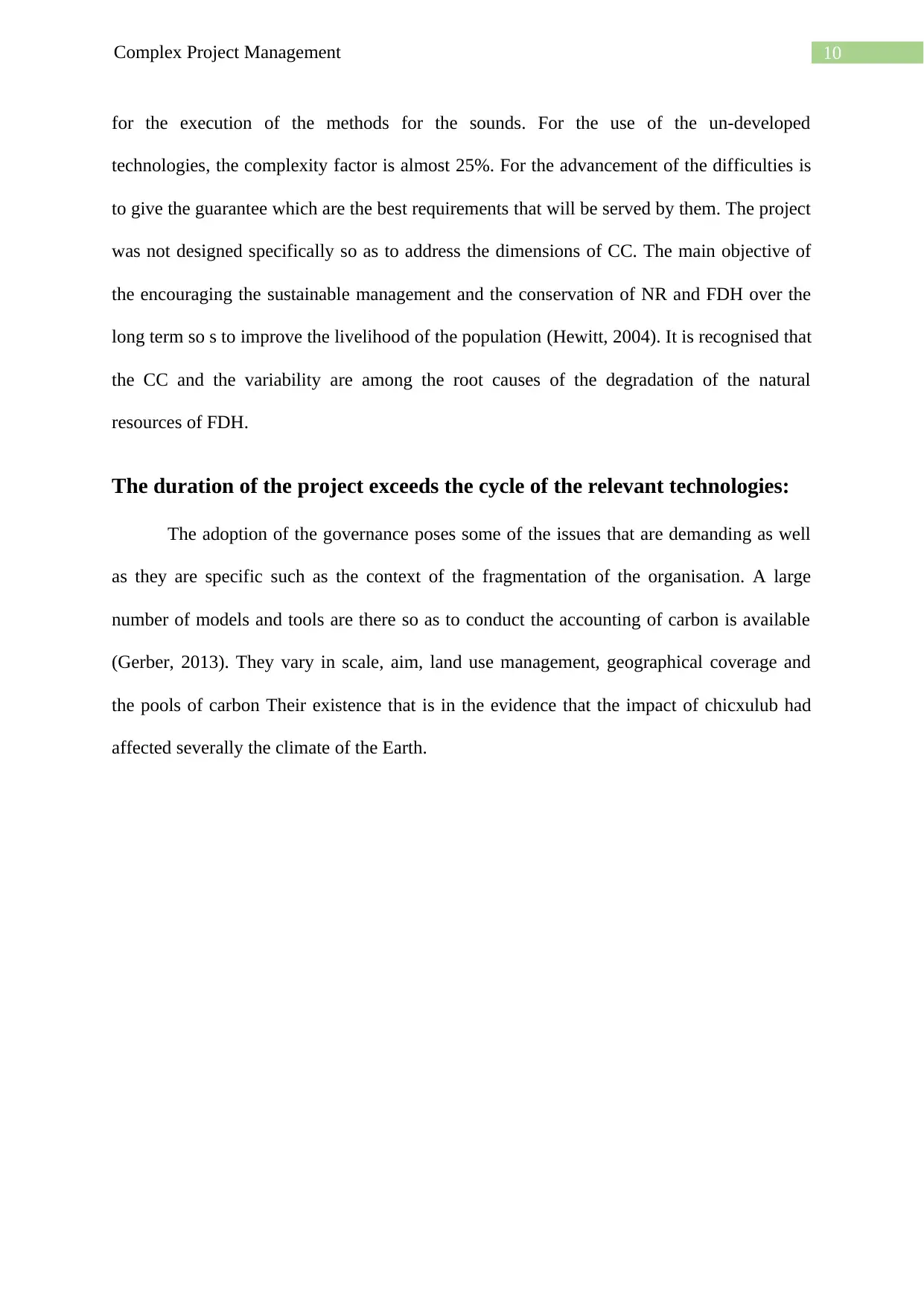
10Complex Project Management
for the execution of the methods for the sounds. For the use of the un-developed
technologies, the complexity factor is almost 25%. For the advancement of the difficulties is
to give the guarantee which are the best requirements that will be served by them. The project
was not designed specifically so as to address the dimensions of CC. The main objective of
the encouraging the sustainable management and the conservation of NR and FDH over the
long term so s to improve the livelihood of the population (Hewitt, 2004). It is recognised that
the CC and the variability are among the root causes of the degradation of the natural
resources of FDH.
The duration of the project exceeds the cycle of the relevant technologies:
The adoption of the governance poses some of the issues that are demanding as well
as they are specific such as the context of the fragmentation of the organisation. A large
number of models and tools are there so as to conduct the accounting of carbon is available
(Gerber, 2013). They vary in scale, aim, land use management, geographical coverage and
the pools of carbon Their existence that is in the evidence that the impact of chicxulub had
affected severally the climate of the Earth.
for the execution of the methods for the sounds. For the use of the un-developed
technologies, the complexity factor is almost 25%. For the advancement of the difficulties is
to give the guarantee which are the best requirements that will be served by them. The project
was not designed specifically so as to address the dimensions of CC. The main objective of
the encouraging the sustainable management and the conservation of NR and FDH over the
long term so s to improve the livelihood of the population (Hewitt, 2004). It is recognised that
the CC and the variability are among the root causes of the degradation of the natural
resources of FDH.
The duration of the project exceeds the cycle of the relevant technologies:
The adoption of the governance poses some of the issues that are demanding as well
as they are specific such as the context of the fragmentation of the organisation. A large
number of models and tools are there so as to conduct the accounting of carbon is available
(Gerber, 2013). They vary in scale, aim, land use management, geographical coverage and
the pools of carbon Their existence that is in the evidence that the impact of chicxulub had
affected severally the climate of the Earth.
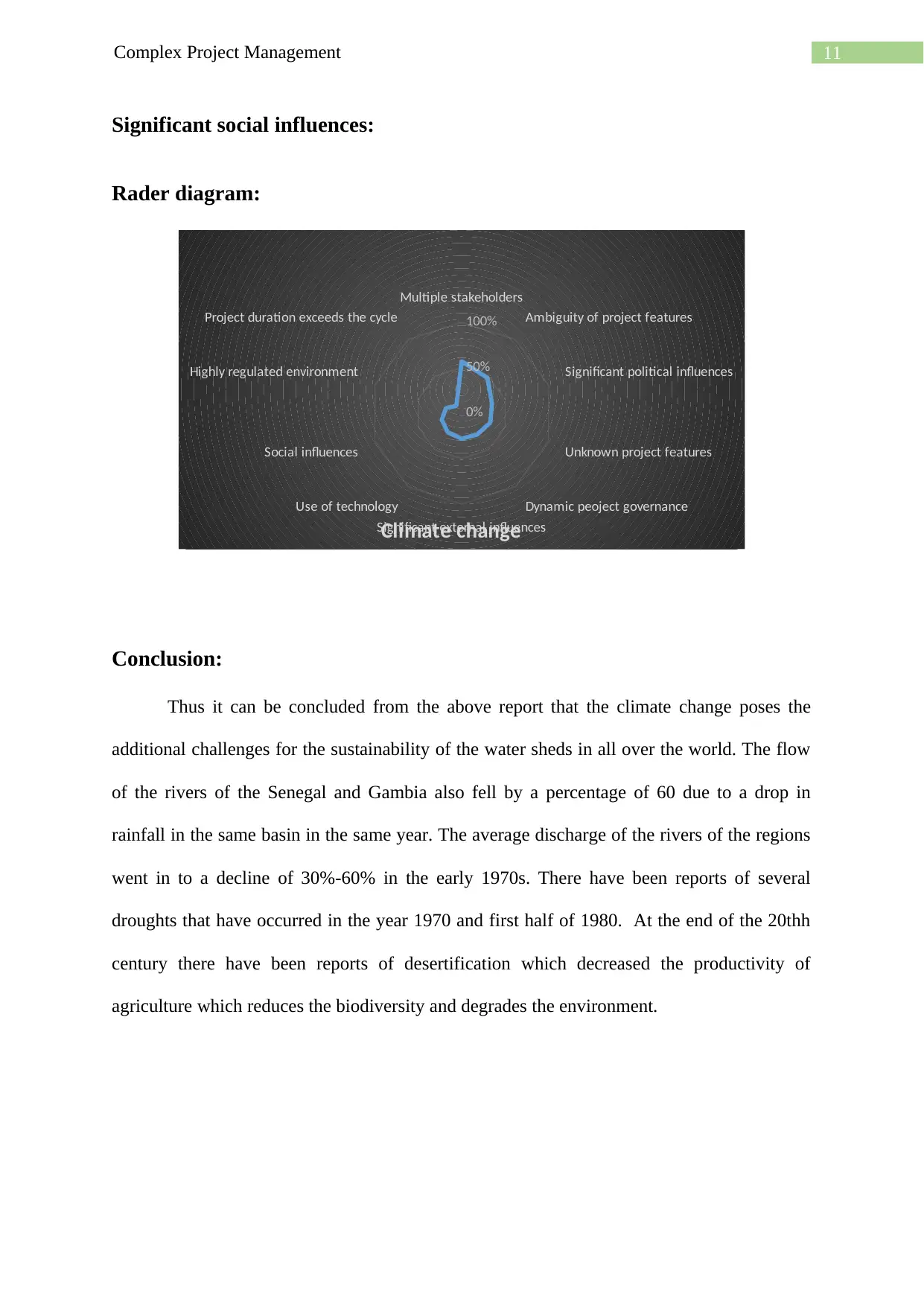
11Complex Project Management
Significant social influences:
Rader diagram:
Multiple stakeholders
Ambiguity of project features
Significant political influences
Unknown project features
Dynamic peoject governance
Significant external influences
Use of technology
Social influences
Highly regulated environment
Project duration exceeds the cycle
0%
50%
100%
Climate change
Conclusion:
Thus it can be concluded from the above report that the climate change poses the
additional challenges for the sustainability of the water sheds in all over the world. The flow
of the rivers of the Senegal and Gambia also fell by a percentage of 60 due to a drop in
rainfall in the same basin in the same year. The average discharge of the rivers of the regions
went in to a decline of 30%-60% in the early 1970s. There have been reports of several
droughts that have occurred in the year 1970 and first half of 1980. At the end of the 20thh
century there have been reports of desertification which decreased the productivity of
agriculture which reduces the biodiversity and degrades the environment.
Significant social influences:
Rader diagram:
Multiple stakeholders
Ambiguity of project features
Significant political influences
Unknown project features
Dynamic peoject governance
Significant external influences
Use of technology
Social influences
Highly regulated environment
Project duration exceeds the cycle
0%
50%
100%
Climate change
Conclusion:
Thus it can be concluded from the above report that the climate change poses the
additional challenges for the sustainability of the water sheds in all over the world. The flow
of the rivers of the Senegal and Gambia also fell by a percentage of 60 due to a drop in
rainfall in the same basin in the same year. The average discharge of the rivers of the regions
went in to a decline of 30%-60% in the early 1970s. There have been reports of several
droughts that have occurred in the year 1970 and first half of 1980. At the end of the 20thh
century there have been reports of desertification which decreased the productivity of
agriculture which reduces the biodiversity and degrades the environment.
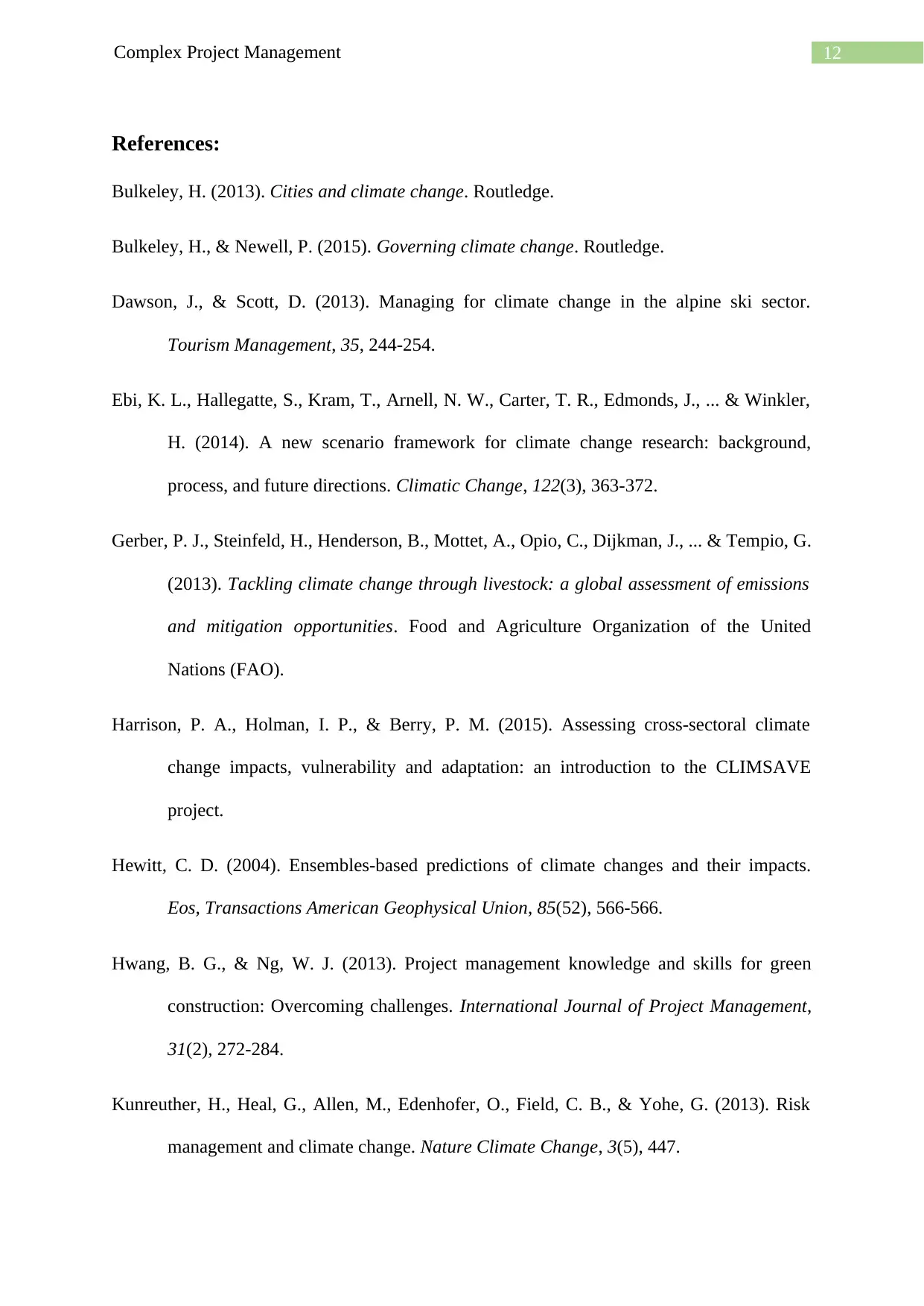
12Complex Project Management
References:
Bulkeley, H. (2013). Cities and climate change. Routledge.
Bulkeley, H., & Newell, P. (2015). Governing climate change. Routledge.
Dawson, J., & Scott, D. (2013). Managing for climate change in the alpine ski sector.
Tourism Management, 35, 244-254.
Ebi, K. L., Hallegatte, S., Kram, T., Arnell, N. W., Carter, T. R., Edmonds, J., ... & Winkler,
H. (2014). A new scenario framework for climate change research: background,
process, and future directions. Climatic Change, 122(3), 363-372.
Gerber, P. J., Steinfeld, H., Henderson, B., Mottet, A., Opio, C., Dijkman, J., ... & Tempio, G.
(2013). Tackling climate change through livestock: a global assessment of emissions
and mitigation opportunities. Food and Agriculture Organization of the United
Nations (FAO).
Harrison, P. A., Holman, I. P., & Berry, P. M. (2015). Assessing cross-sectoral climate
change impacts, vulnerability and adaptation: an introduction to the CLIMSAVE
project.
Hewitt, C. D. (2004). Ensembles‐based predictions of climate changes and their impacts.
Eos, Transactions American Geophysical Union, 85(52), 566-566.
Hwang, B. G., & Ng, W. J. (2013). Project management knowledge and skills for green
construction: Overcoming challenges. International Journal of Project Management,
31(2), 272-284.
Kunreuther, H., Heal, G., Allen, M., Edenhofer, O., Field, C. B., & Yohe, G. (2013). Risk
management and climate change. Nature Climate Change, 3(5), 447.
References:
Bulkeley, H. (2013). Cities and climate change. Routledge.
Bulkeley, H., & Newell, P. (2015). Governing climate change. Routledge.
Dawson, J., & Scott, D. (2013). Managing for climate change in the alpine ski sector.
Tourism Management, 35, 244-254.
Ebi, K. L., Hallegatte, S., Kram, T., Arnell, N. W., Carter, T. R., Edmonds, J., ... & Winkler,
H. (2014). A new scenario framework for climate change research: background,
process, and future directions. Climatic Change, 122(3), 363-372.
Gerber, P. J., Steinfeld, H., Henderson, B., Mottet, A., Opio, C., Dijkman, J., ... & Tempio, G.
(2013). Tackling climate change through livestock: a global assessment of emissions
and mitigation opportunities. Food and Agriculture Organization of the United
Nations (FAO).
Harrison, P. A., Holman, I. P., & Berry, P. M. (2015). Assessing cross-sectoral climate
change impacts, vulnerability and adaptation: an introduction to the CLIMSAVE
project.
Hewitt, C. D. (2004). Ensembles‐based predictions of climate changes and their impacts.
Eos, Transactions American Geophysical Union, 85(52), 566-566.
Hwang, B. G., & Ng, W. J. (2013). Project management knowledge and skills for green
construction: Overcoming challenges. International Journal of Project Management,
31(2), 272-284.
Kunreuther, H., Heal, G., Allen, M., Edenhofer, O., Field, C. B., & Yohe, G. (2013). Risk
management and climate change. Nature Climate Change, 3(5), 447.
Paraphrase This Document
Need a fresh take? Get an instant paraphrase of this document with our AI Paraphraser

13Complex Project Management
Navarro-Ortega, A., Acuña, V., Bellin, A., Burek, P., Cassiani, G., Choukr-Allah, R., ... &
Grathwohl, P. (2015). Managing the effects of multiple stressors on aquatic
ecosystems under water scarcity. The GLOBAQUA project. Science of the Total
Environment, 503, 3-9.
Rose, S. K., Kriegler, E., Bibas, R., Calvin, K., Popp, A., van Vuuren, D. P., & Weyant, J.
(2014). Bioenergy in energy transformation and climate management. Climatic
Change, 123(3-4), 477-493.
Waldhoff, S. T., Martinich, J., Sarofim, M., DeAngelo, B., McFarland, J., Jantarasami, L., ...
& Li, J. (2015). Overview of the special issue: a multi-model framework to achieve
consistent evaluation of climate change impacts in the United States. Climatic
Change, 131(1), 1-20.
Williams, B. K., & Brown, E. D. (2014). Adaptive management: from more talk to real
action. Environmental Management, 53(2), 465-479.
Wise, R. M., Fazey, I., Smith, M. S., Park, S. E., Eakin, H. C., Van Garderen, E. A., &
Campbell, B. (2014). Reconceptualising adaptation to climate change as part of
pathways of change and response. Global Environmental Change, 28, 325-336.
Navarro-Ortega, A., Acuña, V., Bellin, A., Burek, P., Cassiani, G., Choukr-Allah, R., ... &
Grathwohl, P. (2015). Managing the effects of multiple stressors on aquatic
ecosystems under water scarcity. The GLOBAQUA project. Science of the Total
Environment, 503, 3-9.
Rose, S. K., Kriegler, E., Bibas, R., Calvin, K., Popp, A., van Vuuren, D. P., & Weyant, J.
(2014). Bioenergy in energy transformation and climate management. Climatic
Change, 123(3-4), 477-493.
Waldhoff, S. T., Martinich, J., Sarofim, M., DeAngelo, B., McFarland, J., Jantarasami, L., ...
& Li, J. (2015). Overview of the special issue: a multi-model framework to achieve
consistent evaluation of climate change impacts in the United States. Climatic
Change, 131(1), 1-20.
Williams, B. K., & Brown, E. D. (2014). Adaptive management: from more talk to real
action. Environmental Management, 53(2), 465-479.
Wise, R. M., Fazey, I., Smith, M. S., Park, S. E., Eakin, H. C., Van Garderen, E. A., &
Campbell, B. (2014). Reconceptualising adaptation to climate change as part of
pathways of change and response. Global Environmental Change, 28, 325-336.
1 out of 14
Your All-in-One AI-Powered Toolkit for Academic Success.
+13062052269
info@desklib.com
Available 24*7 on WhatsApp / Email
![[object Object]](/_next/static/media/star-bottom.7253800d.svg)
Unlock your academic potential
© 2024 | Zucol Services PVT LTD | All rights reserved.